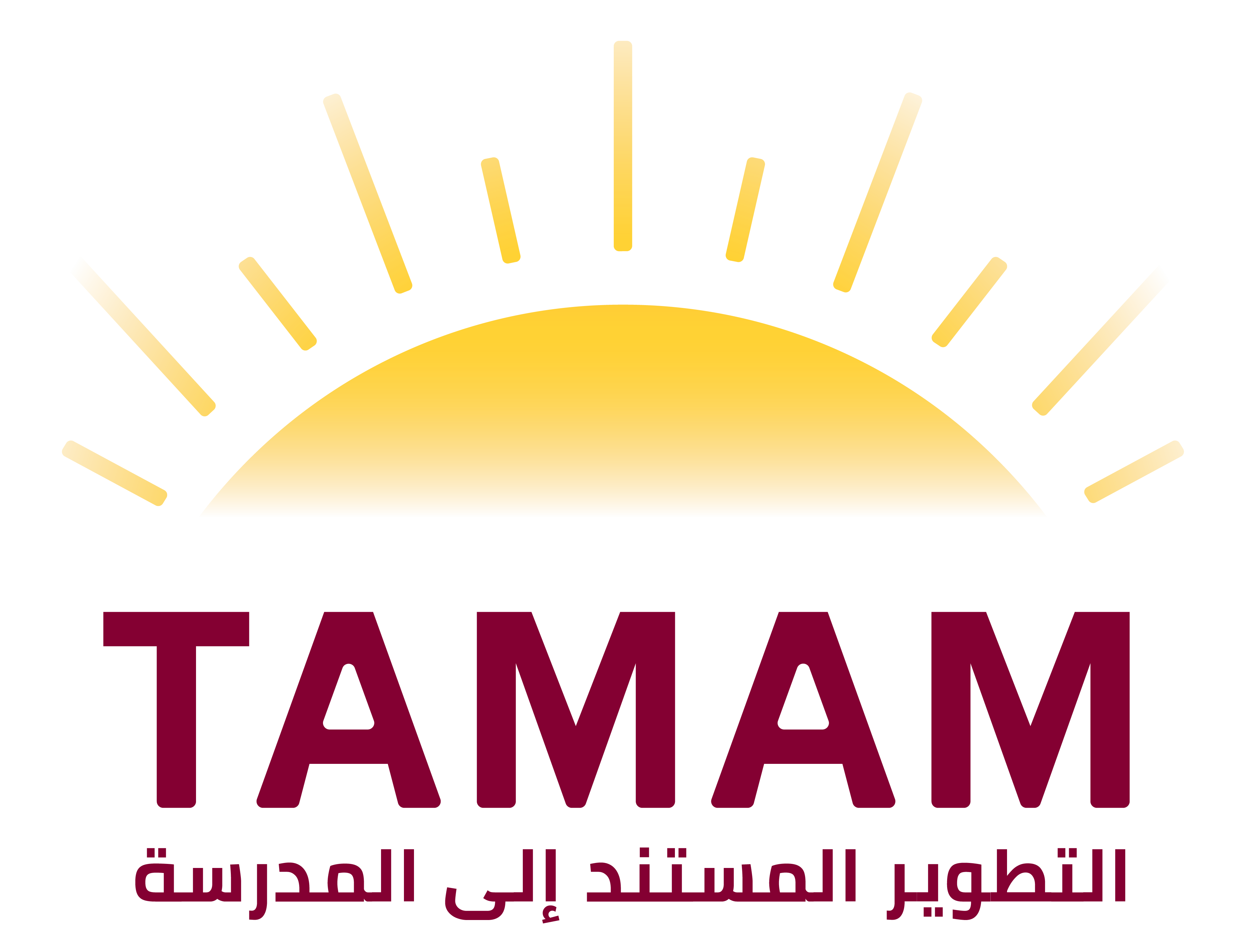*هذه المبادرة تحت اشراف فريق تمام الموجّه ومدرّبين أخصائيّين
في العام 2016، دعت مدارس العصرية إلى إنشاء تجمّع لمدارس تمام الخاصّة في الأردن. دعم الفريق الموجّه هذه الفكرة الواعدة لتوافقها مع التوجهات الاستراتيجية للمشروع وساعد المدارس على تأطيرها ووضع نظام داخلي للتجمّع واختيار لجنة لمتابعة نشاطاته الدورية.
في العام ٢٠١٩، بادرت مجموعة من مدارس التجمع، وهي مدارس العصرية، مدرسة البكالوريا عمّان، مدرستي الأهلية والمطران، مدرسة البيان، ومدرسة المعمدانيّة بالتشبيك للعمل على مشروع تطويري موحّد من خلال السير على رحلة تمام التطويرية لتحسين تعليم اللغة العربية. واكب الفريق الموجّه مبادرة التشبيك التي اتبعت رحلة تمام للتطوير المدرسي في عملها. فبدأت بتحديد وفهم معمّق للحاجة التطويريّة المشتركة بين مدراس التجمّع والمرتبطة ارتباطاً مباشراً بالمتعلّم، حيث قامت الفرق القياديّة بدورات بحث اجرائي في مدارسها، وجمعت معلومات من جهات مختلفة في المجتمع المدرسي (طلاب ومعلمين). وبعد جمع البيانات وتحليلها بطريقة تشاركيّة وتعاونيّة تمّ تحديد الحاجة التطويريّة المشتركة والتي تتعلّق بتعليم اللغة العربيّة.
وبعد توضيح أسباب الاشكالية ومظاهرها، تم وضع رؤية مشتركة تتناول المتعلم، المعلم، المنهاج، الأهل، والبيئة المدرسية. كما تبلورت غاية تطويرية مشتركة بين المدارس مجتمعة وهي ” متعلم شغوف قادر على التواصل باللغة العربية السليمة في سياقيها الحياتي والثقافي “. وحددت الأهداف التطويرية ومؤشراتها التي تطمح لها من هذا المشروع.
تجدر الإشارة إلى أنّ الفريق الموجّه يواكب هذه التجربة عن كثب:
أوّلاً من خلال المتابعة العمليّة لخطوات انطلاقة هذه المبادرة بالتنسيق مع منسقة تجمع تمام في الأردن بالإضافة الى انتداب أختصّاصيّين لغة عربية مطّلعين على مقاربة تمام في التطوير لتدريب الفرق ومواكبة كلّ خطوة يقومون بها. فرافقت د. هنادي دية، الإختصاصية في تعلم اللغة العربية وتعليمها وأ. يسري الأمير، المتخصص باللغة العربية، أعضاء الفرق منذ بداية المشروع للمواكبة واعطاء التوجيهات اللازمة. وقد أثمرت هذه الاجتماعات المكثفة والدورية في عام 2020-2021 عن جدول أعمال واضح للتحضير لتنفيذ خطة المشروع التطويري على مدى ثلاث سنوات لاستهداف الصفوف من أول أساسي حتى الثامن أساسي. وقد تكللت نهاية ذاك العام بمخيم تدريبي بقيادة د. هنادي دية عملت فيه مع قادة اللغة العربية من المدارس المشاركة على تأليف ثلاث سلاسل متّصلة تصف ملامح المتعلّم ومستوى مهاراته اللغويّة في القراءة والكتابة والتخاطب.
ثانيا: من خلال التنسيق مع الاختصاصيين لتنفيذ خطة المشروع التطويري. ففي العام 2021-2022، عمل الاختصاصيون بالتنسيق مع الفريق الموجه على تنفيذ الخطة الموضوعة للعام الأول والعمل بشكل أسبوعي مع قادة اللغة العربية ومعلمي الصفوف المستهدفة للعام الأول وهم صفوف الأول، الثالث، والسادس الأساسي. فقد تم خلال العام الدراسي 2021-2022 إقامة حوالي 75 لقاء مع معلمي الصفوف المستهدفة من قبل أ. يسري الأمير لشرح السلاسل وكيفية استخدامها لتقييم الطلاب تقييما تشخيصيّا، ثم لإنشاء خطط تنفيذية لكل صف تستهدف مهارات القراءة والكتابة والتخاطب بناء على هذا التقييم . وقد واكب أ. يسري المعلمين والقادة أثناء تطبيق الخطط ثم عند تقييم الطلاب تكوينياً ومن ثم تقييمهم تقييماً نهائياً في ختام العام الدراسي. كما تم خلال ذلك العام اجتماعات متابعة وتفكّر دوريّة مع فرق تمام القيادية وقادة اللغة العربية في المدارس المشاركة للتفكّر بتقدّم سير العمل، ولتحديد العقبات التي تعترض العمل والمساعدة في ّ تذليلها وللتفكير بالخطوات اللاحقة لانجاح العمل على هذا المشروع التطويري. واختتمت أعمال العام الدراسي بثلاثة اجتماعات. الاجتماع الأول تم عقده في 23 حزيران/ يونيو 2022 مع جميع المشاركين في هذه المبادرة لشكر المعلمين بالأخص على الجهود التي بذلوها لتنفيذ مشروع اللغة العربية، ولتأطير حصاد التعلم الذي نتج خلال العمل، بالإضافة إلى الحصول على التوصيات والمقترحات للعام المقبل. في 26 يونيو 2022 ، عُقد الاجتماع الثاني مع أعضاء فرق تمام القيادية وقادة اللغة العربية. وقد تم التفكر خلال الاجتماع بسير العمل خلال العام وبالدروس المستفادة منه والتخطيط للعام المقبل. في 17 يوليو 2022، عُقد الاجتماع الثالث والأخير مع مديري المدارس لمناقشة اقتراح د. هنادي دية وأ. يسري الأمير لتدخل العام 2022-2023 وانهاء الخطوات اللازمة لانطلاقة العمل.
افتتح العام 2022-2023 باجتماع عام مع المعلمين وقادة اللغة العربية للفئات المستهدفة الجديدة (الصفوف الثاني والرابع والسابع) بحضور أعضاء فرق تمام القيادية والفريق الموجه والمتخصصين في اللغة العربية. وكان الهدف من الاجتماع ، الذي عقد في 4 سبتمبر ، الإعلان عن انطلاقة المشروع وتأطيره من قبل الفريق الموجه ولمشاركة الحاضرين بخطة العام. تبع ذلك اجتماع مع أعضاء فرق تمام القيادية وقادة اللغة العربية لتسليط الضوء على أهمية التخطيط للتنفيذ آخذين بعين الاعتبار خصوصية كل مدرسة بالإشارة إلى التحديات التي قد تواجه الأعضاء أثناء العمل ودورهم كقادة في مواجهة هذه التحديات. بدأ بعدها أ. يسري الأميرالعمل أسبوعيأ ، مع معلمي وقادة اللغة العربية لتنفيذ الخطة الموضوعة لمشروع اللغة العربية التطويري لصفوف الثاني والرابع والسابع.
ثالثاً، من خلال القيام ببحث معمّق حول الأدبيات المتعلقة بالتشبيك لرفد هذه المبادرة النادرة والنابعة من مدارس عربية بشكل اختياري بالخبرات الموجودة عالميّاً والتي تطرح التشبيك كاستراتيجية واعدة للتطوير التربوي. كما يواكب الفريق الموجه هذه التجربة بحثياً من خلال أطروحة الماجستير التي تعدها المنسقّة العامة لمشروع تمام -أ. رولا القاطرجي- حيث تتناول دراسة تجربة التشبيك لتجمع الاردن بتعمق مستنيرة بالأدبيات عن التشبيك في العالم لفهم هذه التجربة وشروط نجاحها وتحدّياتها ولاستنباط نموذج مجذر في سياقنا حول آليات التشبيك وكيفية توفير الدعم لانجاحه.
يسعى الفريق الموجّه من خلال البحث الاجرائي التعاوني الذي يقوم به تمام كمختبر بحثي إلى نمذجة كل جوانب هذه التجربة لإنتاج خارطة طريق لنموذج مبادرة تشبيك بين المدارس كاستراتيجية للتطوير الواسع النطاق. ولتصميم آليّات تطوير تعليم اللغة العربية، لمشاركتها مع المجتمع التمامي والمجتمع العربي بشكل عام على أمل أن تساهم في حل مبتكر لقضية تعليم اللغة العربية، وذلك لخدمة المتعلم التمامي ولترسيخ الهُوية العربية في مدارسنا.
نأمل أن تكون هذه التجربة انطلاقة لمبادرات تتبعها للتشبيك بين مدارس أخرى ضمن شبكة تمام المهنية وفي الوطن العربيّ.
الخطة الأوليّة
